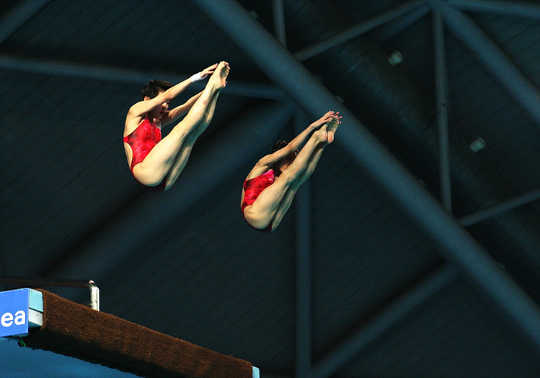
Women’s synchronized diving scores are influenced by the previous dive. ??, CC BY
We often need to make decisions about sequences of things or people rather than just a single item in isolation. For instance, in an everyday setting, we might choose which smartphone to buy after trying out several. There are also more high-stakes situations, of course, like when Olympic athletes compete in a set order as they try to win the gold.
Ideally, it wouldn’t matter when in the sequence you came across the best item or the most outstanding performance, and we certainly hope that scores will be determined in an unbiased way. If they weren’t, competitors would (rightly) complain about how unfair the process was.
But it turns out that people show many biases when performing these sorts of judgment tasks. Our subjective evaluations are influenced by context – that is, the other items to be judged have an effect, even though they probably shouldn’t. For example, people rate faces presented in a group photo as more attractive than when each is rated individually. My latest study adds to the body of psychology research showing that context also includes previously seen faces, athletes and so on.
Where in the order?
People are affected by where an item appears in a sequence. We know that the first and last items are remembered best. They’re also judged more positively during competitions. So if you plan to perform in the “Idol” television series, for instance, you’d be wise to sing at the start or end of the lineup if you can nudge your way there.
How we judge a performance is also affected by the score we just gave. This is because the most immediate (recent) events are used as points of reference – such information is readily accessible, increasing its influence on current decision-making.
Usually, this takes the form of what psychologists call an assimilation effect: If the previous person (or thing) receives a high score, it increases our evaluation of the current person. Conversely, when the previous performance is scored poorly, it decreases the current person’s evaluation.
This pattern seems to be the default for people when presented with sequences. Researchers have identified this type of effect in a variety of situations, including the scoring of Olympic gymnasts, estimates of item prices, ratings of students’ essays and how we judge attractiveness.
On the other hand, sometimes we see the opposite pattern – what psychologists call a contrast effect. In this case, giving a low score to the previous performance will increase the current person’s evaluation. And similarly, giving a high score decreases the rating of the next.
In this case, it seems like your best bet is to compete right after someone who received a low score because they’ll make you look better. Evidence of this type of pattern has been found in speed-dating judgments. In my recent research, we saw the same pattern in Olympic synchronized diving scores. When divers competed right after lower-scoring dives, this boosted their scores, but following a great dive led to athletes receiving lower ratings from the judges. Statistically, I found medium effect sizes in most cases.
So will you get a bump or take a hit?
Researchers are still trying to understand when our judgments will be assimilated and when they will be contrasted with the previous score.
Some evidence suggests similarity is the key. If the current and previous items are similar enough, judges will show assimilation and rate the subsequent item closer to the previous one. But if they are seen to be sufficiently different, a contrast effect will take place and the following item’s rating will be pushed further away. For instance, by altering how similar two consecutive gymnasts appeared (telling participants that they had the same or different nationalities), researchers were able to produce either assimilation or contrast effects in participants’ ratings.
The idea is that initial similarities lead people to search for more of them – these might include similar appearance, age group and so on – causing assimilation. However, when there are obvious differences or judges are already looking for differences, that’s when you see contrast effects.
With the synchronized divers, for instance, I hypothesize that judges are trained to look for the tiniest differences between diving partners (who aim to give identical dives) since these will lead to deductions in their scores. This focus on differences might then generalize to searching for differences from one pair to the next, producing an overall contrast effect for the sequence.
Timing may also play a role. If presentations are very short (fractions of a second, which can be produced in the lab), this may increase the likelihood of assimilation. For longer viewing times, which are more common in natural settings, we may be more likely to see contrast effects. Evidence also suggests that any type of previous-item influences may decrease or vanish altogether when the time between items in the sequence is longer.
Removing biases
Perhaps the best way to prevent these types of biases from affecting competition outcomes is to remove the so-called human element. Computer analysis of synchronized dives, for example, might eventually provide objective measures of performance that could be combined with, or even replace, human judging.
Automatic systems like Hawk-Eye are already being used in tennis, cricket and several other sports as an impartial second opinion. By visually tracking the ball’s movement, these systems can create a 3D representation of its trajectory. Perhaps other types of decisions in competition may one day also be aided by an artificial judge.
Since technology is not yet able to replace human judgments, there may be certain steps we can take to make competitions as fair as possible. First, randomizing the order of competitors will prevent any particular athlete from having a greater chance of appearing in an advantageous position in the sequence (although this won’t remove the biases mentioned). Second, increasing the time between performances as much as possible (subject to the limits of TV broadcasting, human concentration and so on) should decrease some of these biases. Third, I would predict that improving conditions for judges – for instance, giving them more time or allowing them to view the slow-motion replay – could also lead to a decrease in comparisons with previous performances.
To date, there has been little investigation into how these types of biases might be affecting real-world behaviors and competitions. Realizing that athletes could win or lose Olympic medals based upon where in a sequence they compete is both surprising and worrying. With more research into these biases, we can figure out how to prevent them from influencing important outcomes like who goes home with the gold.
![]()
About The Author
Robin Kramer, Postdoctoral Research Fellow in the Department of Psychology, Trent University
This article was originally published on The Conversation. Read the original article.
Related Books
at InnerSelf Market and Amazon























